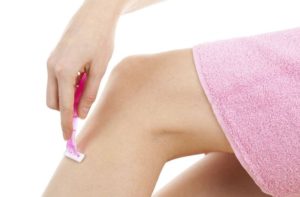Removing unwanted hair has become as much a part of our routines as paying bills (and inspires just as much excitement), but we have good news. Thanks to innovations in hair–removal technology, you can get smoother faster, and with far less irritation. In fact, once you see the seven advancements we’ve discovered–new products and new techniques–you may stop thinking of hair removal as a dreaded chore and may even look forward to it.
- You don’t have to steal his razor anymore
Your significant other’s sturdy metal shaver once had an edge–literally– over your smaller one because it had more blades, an essential detail that gave him a closer shave. As the first blade pulls the hair up slightly, the blades that follow get a really close–to the– root crop. But women’s products have closed the gender gap, with new models featuring up to five blades– such as the Gillette Venus Embrace Razor -making it easier to eliminate hair on your legs, underarms, and bikini line with fewer nicks and bumps. To further reduce irritation, prep the skin with shaving cream before removing hair; it’s more hydrating and allows for a less painful shave than soap does. Skin–loving best bets: Whish Shave Crave Pump in Pomegranate, Skintimate Shave Gel in Flirty Mango, and Pure Silk Moisturizing Shave Cream for Women in Melon Splash.
- The newest depilatories are practically odor–free and work faster than ever
“The original versions owed their strong scent to the chemicals calcium thioglycolate and sodium hydroxide, active ingredients that dissolve hair,” says Loretta Ciraldo, M.D., a clinical professor of dermatology at the University of Miami. While these ingredients are still used, they’re now paired with pleasant scents that help neutralize their odor. Depilatories are also no longer messy: They come in a variety of formulas (sprays, creams, gels, and lotions) designed to stay put as they do their job, usually in 10 minutes or less. Veet in Shower Hair Removal Cream is even water–resistant, so you can use it in the shower while you’re shampooing (it won’t rinse off until you wipe it with a washcloth). The latest products are also less harsh, thanks to hydrators that create a buffer against potentially irritating ingredients. Try Sally Hansen Extra Strength Spray–On Shower–Off Hair Remover with moisturizing shea and cocoa butter.

- You can get the same waxing results at home as you can at a salon/spa
The newest at–home waxing kits contain professional–quality wax to minimize post–treatment bumps. The gentlest versions, like Nair Salon Divine Microwaveable Body Wax Kit ($14; at drugstores), contain glyceryl rosinate, an ingredient that makes the wax softer and more pliable, allowing it to stick to your hair rather than to your skin. Another product that’s made the removal process easier: pellon strips. “Good–quality pellon is a stiffer, less porous fabric than traditional muslin; the wax doesn’t seep through,” says Jodi Shays, owner of Queen Bee Waxing in Los Angeles. “This allows the strip to grip even the smallest hairs firmly.”
- You can end your battle with ingrowns; you just have to treat your skin right
There are few things more frustrating than spending time and cash to go bare only to see unsightly bumps flare up. “Whenever you pull out the hair from below the skin, you run the risk of triggering ingrowns,” says Ciraldo. “These can be caused either by bacteria entering the follicle or by new growth getting caught under the skin.” The fix? Products with pore–unclogging glycolic or salicylic acid, such as Queen Bee Buzz off Bumps cleansing pads or the Art of Shaving Ingrown Hair Night Cream.
- Lasers can be used on almost any skin type
“The lasers we used 10 years ago were only effective on people who had dark hair and light skin,” says Susan C. Taylor, M.D., a dermatologist in Philadelphia. “But now lasers target the pigment in the hair rather than the pigment in the skin, so they work for women with darker skin too.” As the hair absorbs the light, intense heat causes damage to the hair follicle. “This leads to gradual destruction of the hair, about a 20 to 25 percent reduction with each visit,” says Bruce Katz, M.D., director of the Juva Skin & Laser Center in New York City. Since lasers create heat, getting zapped can be painful, but numbing gels help take the sting out (most take 20 minutes to work), as do the newest machines: The Apogee Elite laser, for instance, uses an air–cooling system to soothe the skin. Prices vary from around $150 per session for treating the bikini area to $500 to $800 per session for arms or legs.
- Creams work even better at slowing hair growth
Vaniqa, a prescription cream with the chemical eflornithine, blocks the enzyme necessary for hair growth and keeps you smooth longer in between hair removal (no matter what method you use). In fact, roughly 94 percent of women who treated their upper lips with both Vaniqa and a laser experienced almost complete hair removal, versus about 70 percent for women who underwent laser sessions alone, according to a study in the Journal of the American Academy of Dermatology.
- The new epilators are far more gentle than their predecessors
When epilators– handheld machines that yank multiple hairs out by the root–were launched in the eighties, they were draconian devices that called for a considerable pain threshold. While you may have vowed never to let anything starting with “epi” near your skin again, we promise there’s good reason to give these electronic hair removers another shot. Several manufacturers have reworked the design: Now, rather than a rotating coil that roughly pulls at hair (and your skin), the new devices use rows of tiny tweezers to gently lift, loosen, and remove even the shortest strands. “You’ll still feel stinging, but the sensation is significantly less painful than before,” says Ciraldo. Plus, some devices, like the Bliss–Philips Bikini Perfect Deluxe Spa Edition ($70; blissworld.com) and the Braun SilkÉpil Xpressive, can be used as both a trimmer (so you can trim hair to the recommended 0.5–millimeter length before epilating) and an epilator.
Source: shape.com




